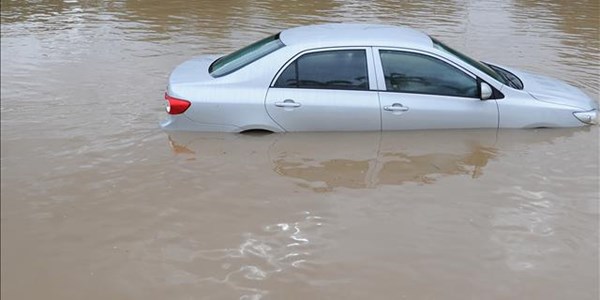Human Interest
Lifesaving flood safety tips you should know─── 07:14 Sat, 18 Feb 2017

With the tropical storm Dineo making landfall in South Africa earlier this week, the focus has once again fallen on flood safety.
According to Arrive Alive, water that is only 40cm deep can reach a speed of more than 3km/h and is enough to sweep a car off a bridge. A water depth of only 60cm can float a car. Motorists are cautioned not to drive through water that is more than 20cm deep as this could also damage their vehicle components.
The SA Weather Service also warns that about 66% of flood deaths occur in vehicles. While it is best to avoid flooded situations, tips to negotiate flooded roads include pulling over and looking for higher ground, and unlocking doors, opening windows and taking off your seatbelt should you be swept away.
Arrive Alive provides the following flood safety tips for drivers
1. Obey authorities and emergency personnel who tell you to avoid driving on a specific road. If a road has been closed, obey the closure, and drive the alternative route.
2. Do not try and cross a body of water, even if you think you can make it, as the water may be deeper than you think, and the road may have eroded since you last used it.
3. If there is a risk you will be caught in a flood, pull off the road and look for higher ground.
4. If you do pull off, make sure you leave enough space for emergency vehicles to pass you.
5. If you have no alternative but to drive through a body of water, drive as slow as possible in first gear with both hands on the steering wheel. This will give your car the necessary traction to move forward. Driving fast may result in aquaplaning.
6. Ensure you are as visible as possible. Switch on your headlights.
7. If your car is being surrounded by water, unfasten your seatbelt (and those of any children with you), unlock your doors, and open your windows. If water starts entering through the windows, get out of the vehicle and wade to the nearest point of safer higher ground. Remember, you are more important than your car.
8. If your car is suddenly submerged and your windows aren’t already open, try and break a window and swim to the nearest point of safety.
The SA Weather Service also advises:
1. Do not drink floodwater since it may be polluted.
2. Stay away from collapsed power lines and cables after a flood as live electricity could still pass through them.
3. Turn off the electricity during a flood, because water is a good conductor of electricity and could cause electrocution.
4. Store away clean drinking water and food.
5. Listen to weather reports and instructions of local disaster managers. If necessary, evacuate the area.
After a flood
1. Listen for news reports to learn whether the community’s water supply is safe to drink.
2. Avoid floodwaters; water may be contaminated by oil, gasoline, or raw sewage. Water may also be electrically charged from underground or downed power lines.
3. Avoid moving water.
4. Be aware of areas where floodwaters have receded. Roads may have weakened and could collapse under the weight of a car.
5. Stay away from downed power lines, and report them to the power company.
6. Return home only when authorities indicate it is safe.
7. Service damaged septic tanks, cesspools, pits, and leaching systems as soon as possible. Damaged sewage systems are serious health hazards.
8. Clean and disinfect everything that got wet. Mud left from floodwater can contain sewage and chemicals.
-wheels24.com/SAWeather













